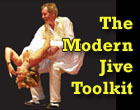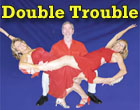
What Is Modern Jive?


|
What Is Modern Jive?
|

|
You will probably get a different answer depending on whom you ask. Here is my version!

Modern Jive is the simplest of all partner dances. Since there is no footwork to learn, within half an hour your local club will have you dancing to the biggest chart hits of today and yesterday, with lots of different partners. Its lack of restriction means that there are literally hundreds of moves of every kind for you to use to expand your repertoire.
For the full background see The Modern Jive Timeline.
The short version is:
In 1980 some clever people in London realised that they could get more people dancing a partner dance similar to jive if they didn't try to teach them any footwork. So they devised simple moves which could be taught quickly and only involved the dancers walking to the beat - not worrying about which foot was which.
This developed into a variety of styles involving hundreds of moves ranging from simple to complex, and danced by hundreds of thousands of people across the world.
A generic name for these new styles is Modern Jive, but most people learn it at a club and use the name of the club to refer to the dance; examples include Ginger Jive, Northern Jive, Jive+, Just Jivin', Mo'jive and Blitz.
Modern Jive used sometimes to be known as "French Jive" in the UK, but I danced quite a lot in France in the 1990s and never found anyone over there who danced Modern Jive the way it is done in the UK!
When Michel Lau created the dance style in London in the early eighties he called it Le Roc (later changed to LeRoc) and intentionally did not brand it, so that the name LeRoc can be used by anyone. Many clubs use the word LeRoc in their name, and there is also the LeRoc Modern Jive Federation which is a federation of independent Modern Jive teachers.
"Ceroc" is a brand name. It has been branded by different organisations in different countries; these organisations are some of the biggest and most successful chains of clubs. In Australia, New Zealand and some other countries Ceroc is considered a form of Modern Jive.
For Ceroc Enterprises Ltd in the UK and across Europe, Ceroc is a method of teaching and not a style of dance. For more than a decade, what Ceroc UK teaches at its regular classes is dance in a general form rather than a specific dance. Ceroc in the UK is not associated with, related to, aligned with or indeed teaches anything that could be described as Modern Jive. For more information about Ceroc UK see "What is Ceroc".
Most clubs have a standard evening format something like:
"Freestyle" dancing just means the man (or "leader") leads the lady (or "follower") through a sequence of moves selected randomly by the man. Most people change partners after every track or two so you get plenty of variety.
As far as I am concerned Modern Jive is wonderful because:
Actually, to be quite honest, you can't easily dance Modern Jive to ALL the great hits - some of them are too slow and some of them too fast. Modern Jivers tend to like music which is between 110 and 160 beats per minute, but the better ones can cope with other speeds.
Most Modern Jive clubs teach a standard range of Beginner and Intermediate moves at their normal club nights. If you want to learn more then there are lots of opportunities:
When Modern Jive was created it borrowed heavily from French jive styles and older influences such as Lindy Hop, Swing and Rock 'n' Roll. Many people find that once they have mastered the basics of Modern Jive and have discovered that they CAN make their feet do what they want, they would like to try some of these other styles.
Whatever you try, I wish you good luck and hope you enjoy it!
Happy dancing,
John

|
|

|